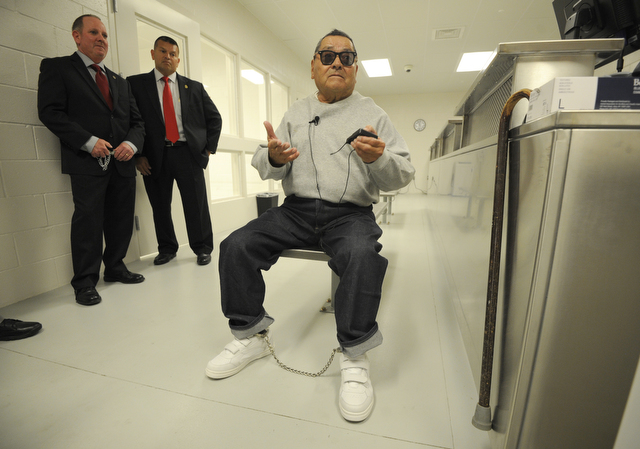Inside Santa Maria’s ICE Machine
Media Tour the Debated New Building After Summer Opening

Four months ago, after intense community resistance to its opening, Santa Maria’s new Immigration and Customs Enforcement (ICE) headquarters quietly began operations. In that time, agents working in the nondescript gray building on Century Street between a towing yard and porn distributor have processed more than 250 migrant offenders on their way toward likely deportation. Celso Leon-Garcia is one of them.
On Tuesday, the 74-year-old native of Guanajuato, Mexico, was sitting in one of the facility’s three holding cells opposite a tattooed gang member from Cuba. Leon-Garcia had just been released from the California Men’s Colony in San Luis Obispo after serving a 30-year prison sentence for second-degree murder. He said matter of factly that he shot a man near Fresno who was threatening his son and that he was excited to reunite with family in Tijuana.
ICE officials later stated Leon-Garcia entered the U.S. illegally in 1971 and was deported before once again making the journey north. They said the Cuban gang member, who declined to be identified, possessed both a green card and lengthy rap sheet. Within a matter of hours, the two men would be driven to the Los Angeles area for deportation hearings, at which they could petition for asylum. Mexican nationals ordered back across the border are handed off through a special gate at the San Ysidro crossing, explained David Marin, an ICE deputy field office director out of L.A. After that, it’s up to Mexican authorities where they go. If they have no clear home base, they often return to the U.S., Marin said.
During Tuesday’s media tour, Marin made repeated efforts to dispel concerns that the Santa Maria facility is a long-term lockup or militarized headquarters for deportation sweeps. Those worries were aired during Santa Maria City Council and Planning Commission hearings last year that drew hundreds of demonstrators arguing ICE’s presence would strike anxiety and fear among the area’s large Latino community. Congressmember Lois Capps expressed her own reservations at the time.
“This is not a detention center,” Marin said. “It’s office space that just has a processing area.” He pointed to the bank of cubicles that fill the building’s main room and noted how the holding cells, which can house up to 13 people total, occupy just a tenth of its floor plan.
Marin explained the building mostly acts as a temporary waypoint for detainees who have completed their prison or jail terms but are candidates for deportation. The 10,000-square-foot structure replaced 40-year-old trailers on the Lompoc prison grounds and serves that penitentiary, the Men’s Colony, and San Luis Obispo County Jail. Offenders picked up from the Santa Barbara County Jail are processed at ICE’s Camarillo office, though if and when the North County Jail opens in the next three years, the Santa Maria center would handle those cases. It is budgeted for 12 field agents and has desk space for a number of additional officers should more federal funding become available.
Agents also make arrests on the street at a rate of 15 or so a month, mostly for DUI and domestic-violence offenses but also for more serious drug- and gang-related crimes. On a daily basis, area residents stop by to report suspicious activity or individuals they think are in the country illegally. One woman recently gave the identity of her husband’s girlfriend.
ICE supervising agent Steven Finn said that, overall, 95 percent of people processed through Santa Maria are Mexican nationals. Others come from Guatemala, El Salvador, Honduras, and the Philippines. The office, Marin went on, doesn’t have the desire or resources to conduct indiscriminate raids in neighborhoods and workplaces, as critics have claimed it would. “We don’t go out into the community and just target anybody,” he said. “Anybody we go after is someone we know has a criminal conviction, has been previously removed, or is a serious threat to the community.”
Prompted by lingering confusion over some of ICE’s detainment policies, Santa Barbara County supervisors have asked for more detailed information from the federal agency on how many undocumented individuals are being held in the County Jail, how many detainees are deported each year, and how many high-priority offenders remain free. Members of Central Coast Alliance United for a Sustainable Economy (CAUSE), who recently took their own tour of the Santa Maria building after a request from Rep. Capps for more dialogue between the group and ICE, are still calling for greater transparency from the department.
ICE agents last month made 49 arrests in Santa Barbara during a 30-day enforcement effort that covered multiple jurisdictions. That sweep came on the heels of a four-day operation in seven Southern California counties that resulted in 20 arrests in Santa Barbara. ICE officials said they targeted individuals who fell into the agency’s Priority I or Priority II classifications — meaning they were convicted of felonies, or multiple or significant misdemeanors — and the busts were in response to the state’s prison realignment measure that resulted in more inmates being released from county jails. In both sweeps, most of the local arrests occured in Santa Maria.


